Muslim Autonomist Movement in Bosnia and Herzegovina during World War II and Its Role in the Plans of the Nazi Germany
Keywords:
Bosnia and Herzegovina, World War II, collaboration, autonomist movement, Independent State of Croatia (NDH), 13th SS DivisionAbstract
In the following article the author provides a comprehensive overview of the Muslim Autonomist Movement in Bosnia and Herzegovina (BiH), which took place in different historical periods. The first attempt at achieving autonomy took place in the 19th century in the time of the Ottoman Empire, the second in the time of the Austro-Hungarian occupation of BiH, the third in the period of the Kingdom of Serbs, Croat and Slovenes/Kingdom of Yugoslavia, while the fourth attempt occurred in the time of World War II. In all these periods the autonomist movement represented the opposition to the ruling structures. During the time of World War II, the autonomist movement wanted to adapt to the new situation under the German occupation. Its adherents saw power and order in Germany, which would ensure the regulation of the situation in BiH. Basically this movement was not pro-Nazi; its intentions were to protect the Muslims from the Chetnik and Ustashe violence.
Downloads
Published
Issue
Section
License
Authors who publish with this journal agree to the following terms:
- Authors retain copyright and grant the journal right of first publication with the work simultaneously licensed under a Creative Commons Attribution License that allows others to share the work with an acknowledgement of the work's authorship and initial publication in this journal.
- Authors are able to enter into separate, additional contractual arrangements for the non-exclusive distribution of the journal's published version of the work (e.g., post it to an institutional repository or publish it in a book), with an acknowledgement of its initial publication in this journal.
- Authors are permitted and encouraged to post their work online (e.g., in institutional repositories or on their website) prior to and during the submission process, as it can lead to productive exchanges, as well as earlier and greater citation of published work (See The Effect of Open Access).


